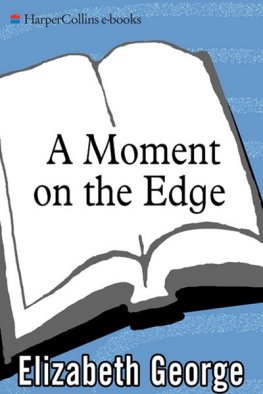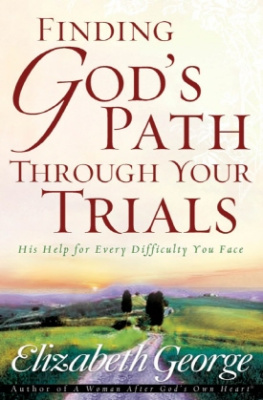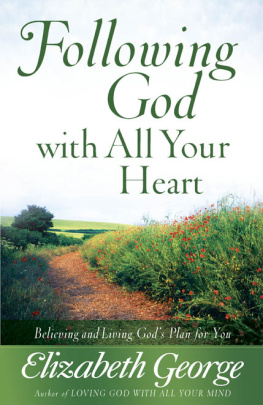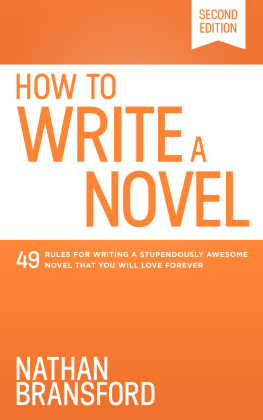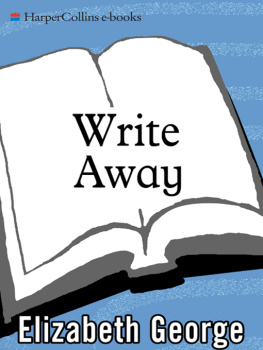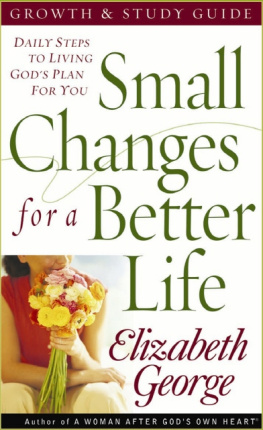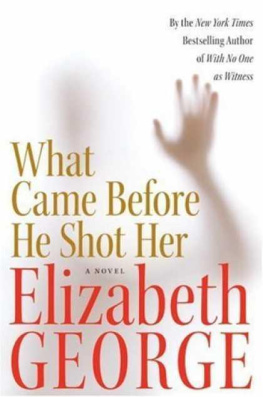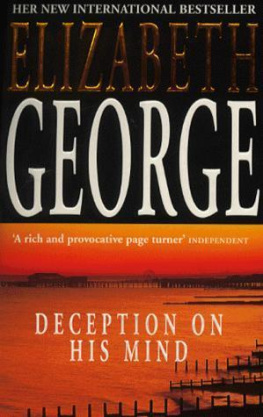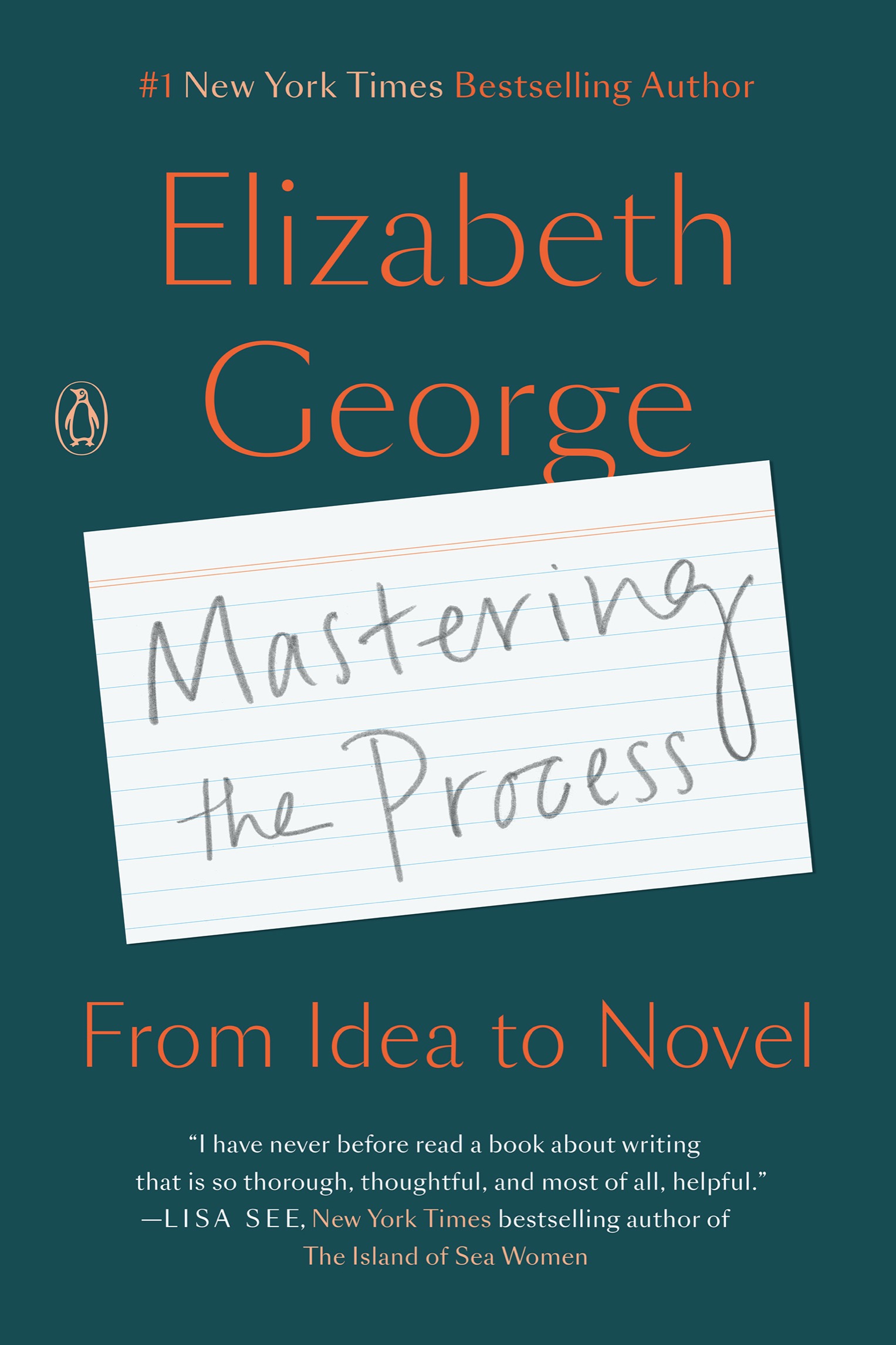A LSO BY E LIZABETH G EORGE
F ICTION
A Great Deliverance
Payment in Blood
Well-Schooled in Murder
A Suitable Vengeance
For the Sake of Elena
Missing Joseph
Playing for the Ashes
In the Presence of the Enemy
Deception on His Mind
In Pursuit of the Proper Sinner
A Traitor to Memory
I, Richard
A Place of Hiding
With No One as Witness
What Came Before He Shot Her
Careless in Red
This Body of Death
Believing the Lie
Just One Evil Act
A Banquet of Consequences
The Punishment She Deserves
Y OUNG A DULT
The Edge of Nowhere
The Edge of the Water
The Edge of the Shadows
The Edge of the Light
N ONFICTION
Write Away: One Novelists Approach to Fiction and the Writing Life
A NTHOLOGY
A Moment on the Edge: 100 Years of Crime Stories by Women
Two of the Deadliest: New Tales of Lust, Greed, and Murder from Outstanding Women of Mystery
PENGUIN BOOKS
An imprint of Penguin Random House LLC
penguinrandomhouse.com
First published in the United States of America by Viking, an imprint of Penguin Random House LLC, 2020
Published in Penguin Books 2021
Copyright 2020 by Susan Elizabeth George
Penguin supports copyright. Copyright fuels creativity, encourages diverse voices, promotes free speech, and creates a vibrant culture. Thank you for buying an authorized edition of this book and for complying with copyright laws by not reproducing, scanning, or distributing any part of it in any form without permission. You are supporting writers and allowing Penguin to continue to publish books for every reader.
Grateful acknowledgment is made to HarperCollins Publishers for permission to reprint excerpts from Careless in Red by Elizabeth George. Copyright 2008 by Susan Elizabeth George. Courtesy of HarperCollins Publishers.
by Anastasiya Lobanovskaya, courtesy of Pexels.
by Vincent Tan, courtesy of Pexels.
All other images courtesy of the author.
ISBN 9781984878335 (paperback)
the library of congress has cataloged the hardcover edition as follows :
Names: George, Elizabeth, 1949 author.
Title: Mastering the process : from idea to novel / Elizabeth George.
Description: New York : Viking, 2020. | Includes bibliographical references.
Identifiers: LCCN 2019042814 (print) | LCCN 2019042815 (ebook) | ISBN 9781984878311 (hardcover) | ISBN 9781984878328 (ebook)
Subjects: LCSH: FictionAuthorship. | FictionTechnique. | Plots (Drama, novel, etc.) | Creative writing.
Classification: LCC PN3365 .G46 2020 (print) | LCC PN3365 (ebook) | DDC 808.3dc23
LC record available at https://lccn.loc.gov/2019042814
LC ebook record available at https://lccn.loc.gov/2019042815
pid_prh_5.5.0_c0_r1
For my Sistahs:
Gail
Karen Joy
Jane
Nancy
Writing, Id seen, demands a ferocious, all-consuming commitment, a refusal to be distracted.
P ICO I YER ,
The Man Who Told Futures
Contents
Prologue
When Write Away was first published in 2004, I had no thought of writing a follow-up volume to it. But after a number of years during which I taught writing courses and appeared at writers conferences, I began to see that creating a process book that used one of my novels as an example of each step of my own process might prove useful to people who are interested in novel writing or in how this one individual writer approaches the complicated task of putting together a British crime novel.
Let me first explain how I developed my process for creating a novel.
When my first to-be-published novel was acquired by Kate Miciak at Bantam Books, I waited anxiously for an editorial letter. I knew enough about the craft of writing and the world of publishing to understand that its a rare occurrence for a novel to be accepted and then published without editorial input. So I understood that my work on A Great Deliverance wasnt complete. What I didnt see was that my work on A Great Deliverance was far from complete. The editorial letter I received from Kate three and a half months later was nine pages long, comprising twenty-two paragraphs. The twenty-two paragraphs consisted of nothing but questions. It was my job to answer these questions somehow in whatever way I saw fit within the body of the novel as I revised it. Looking back, I recall that creating the answers to these questions added in the vicinity of one hundred pages to the manuscript.
It was a task that I didnt wish to repeat. So once I had completed it, I studied Kates letter to see how I could avoid having to do so much editor-requested work on my next novel. From my study of the letter, I saw that there were two areas toward which Kate directed most of her questions. One was toward a fuller examination of place, and the other was toward a fuller exploration of character.
So I asked myself: In my next novel, what can I do to illustrate place with more depth and verisimilitude? How do I make my characters more real? The answers that I developed gave me the first two elements of what ultimately became my process.
Initially, I came to understand that I would have to examine far more closely any setting I wished to use in the future. These were the days before the Internet, so the onus was on me to come up with a way to make place jump out for the reader. I did this by upping the quality and intensity of every prewriting activity I engaged in to understand a place when I was in England trying to decide where to set a novel. That meant making more copious notes about what I saw in every location, taking far more photographs, learning the flora and the fauna of any area in which I might wish to set a scene, recording all sensory impressions of a place, conducting interviews when necessary. I would also need to purchase brochures and books, Ordnance Survey maps, road atlases of the individual areas, and hundreds of postcards. I would have to learn the architectural style and the building materials of any county I was investigating, as well as the geology and the topography. I would have to listen carefully to people speaking around me. I would have to watch carefully people living their lives around me. From all of this, I would then create a setting, and I would do this in advance of any writing of the novel itself. In this way, when I placed a character in a scene of the book, I would have notes and photographs and maps and booklets to use in order to make the location real for the reader. If necessary, I would create my own map of the location, especially if I wasnt using a place that actually exists or if I was combining several places into one for the purpose of my story.
Second, I would have to create my characters in advance. Once I had the kernel of the story (which quite often emerges from my experience of the place in which the story will occur), I would need to people that kernel with the various individuals who logically would be involved in the tale I wanted to tell. Since I write crime novels, this peopling of the story would begin with the victim and the killer and would spread out from there. But creating the characters in advance couldnt mean just knowing that there would befor examplefive generic suspects, a generic killer, and a generic victim. Additionally, creating them in advance couldnt mean I was merely giving them names and ages. Those pieces of information wouldnt make them real to my editor or, actually, to me either.




